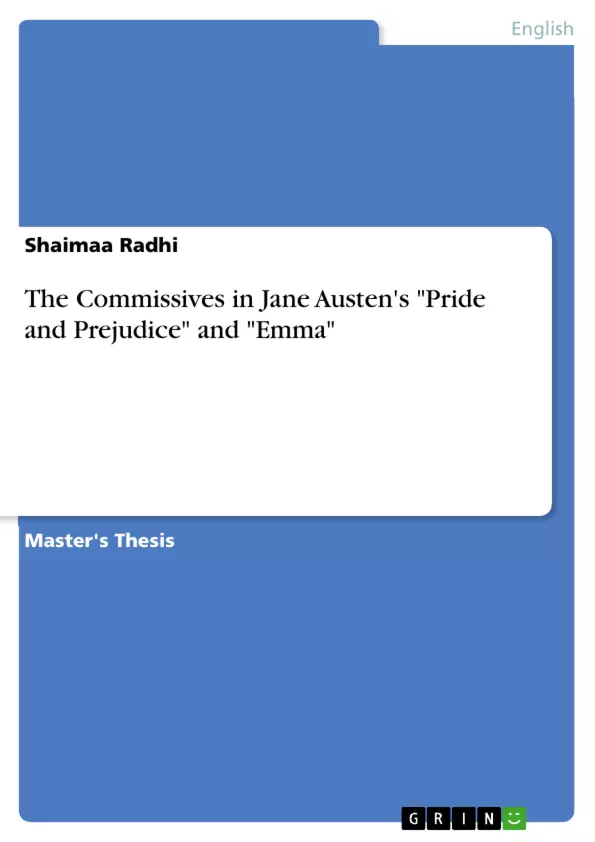This thesis is an attempt to study three commissive speech acts, namely offer, promise, and refusal in Jane Austen's “Pride and Prejudice” and “Emma”.
The study treats the problem whether the mentioned speech acts are employed directly or indirectly, which politeness strategy is mostly used to perform them, whether their grammatical structures run in parallel to those found in literature concerning them, and which one is the dominant among the three speech acts.
Consequently, the study aims at investigating offer, promise, and refusal in Austen's Pride and Prejudice and Emma, finding the most common pragmatic strategies used to express the speech acts, finding the politeness strategies, and the type of grammatical structures used in the data, setting up the felicity conditions for the commissives in the novels, and comparing the two selected novels according to the type of speech act, grammatical structure, and politeness strategy.
Inhaltsverzeichnis (Table of Contents)
- Chapter One: Preliminaries
- 1.1 The Problem of the Study
- 1.2 Aims of the Study
- 1.3 Hypotheses of the Study
- 1.4 Procedures
- 1.5 Limits
- 1.6 Significance
- 1.7 Definitions of Basic Terms
- 1.8 Methodology of the Study
- 1.8.1 Data of the Study
- 1.8.2 The Model Adopted and the Mathematical Technique
- 1.9 Jane Austen's Life and Works
- 1.9.1 Pride and Prejudice
- 1.9.2 Emma
- Chapter Two: Commissive Speech Acts
- 2.1 Pragmastylistics
- 2.2 Speech Act Theory
- 2.2.1 Definition
- 2.2.2 Classifications
- 2.3 Speech Acts and Politeness
- 2.4 Commissives Analysis
- 2.4.1 Speech Act of Offer
- 2.4.2 Speech Act of Promise
- 2.4.3 Speech Act of Refusal
Zielsetzung und Themenschwerpunkte (Objectives and Key Themes)
This thesis aims to analyze commissive speech acts, specifically offer, promise, and refusal, in Jane Austen's Pride and Prejudice and Emma. The study investigates how these speech acts are employed, the politeness strategies used, and the grammatical structures involved. Additionally, it aims to compare the two novels based on the type of speech act, grammatical structure, and politeness strategy.
- The study examines the pragmatic strategies used to express commissive speech acts in the novels.
- It analyzes the politeness strategies used to perform these speech acts.
- The thesis investigates the grammatical structures used to express offer, promise, and refusal in the novels.
- The study compares the two novels based on the prevalence and characteristics of commissive speech acts.
- The study examines the role of commissive speech acts in conveying female characters' language.
Zusammenfassung der Kapitel (Chapter Summaries)
- Chapter One: Preliminaries This chapter sets the stage for the study, outlining the problem, aims, hypotheses, procedures, limitations, significance, and definitions of key terms. It also provides biographical information on Jane Austen and a brief overview of Pride and Prejudice and Emma.
- Chapter Two: Commissive Speech Acts This chapter presents a literature review of commissive speech acts, covering topics such as pragmastylistics, speech act theory, and politeness strategies in relation to commissives. It also delves into the specific analysis of offer, promise, and refusal.
- Chapter Three: Analysis of Commissives in Pride and Prejudice This chapter analyzes the commissives found in Pride and Prejudice, focusing on the types of speech acts, grammatical structures, and politeness strategies used.
- Chapter Four: Analysis of Commissives in Emma This chapter analyzes the commissives found in Emma, following the same methodology as Chapter Three, and comparing the findings with those of Pride and Prejudice.
Schlüsselwörter (Keywords)
The primary keywords and focus topics of this thesis are: Jane Austen, Pride and Prejudice, Emma, commissive speech acts, offer, promise, refusal, pragmatics, politeness theory, grammatical structure, pragmatic strategies, politeness strategies, female characters' language.
- Quote paper
- Shaimaa Radhi (Author), 2017, The Commissives in Jane Austen's "Pride and Prejudice" and "Emma", Munich, GRIN Verlag, https://www.grin.com/document/378354



